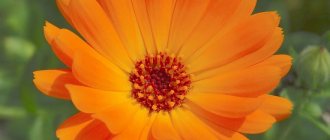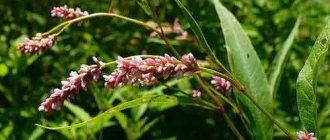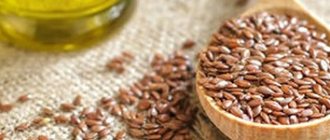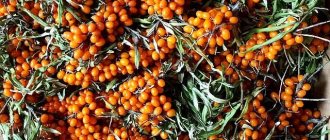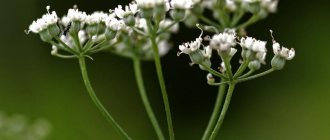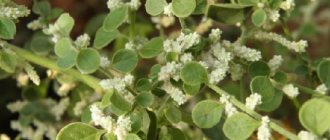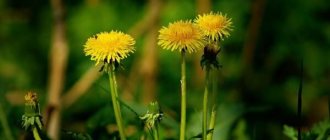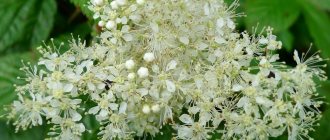Knotweed, which is quite widespread, is a herbaceous plant that has medicinal properties. It has a hemostatic and mild laxative effect on the body.
It grows everywhere - along the banks of rivers, lakes, in meadows, fields, gardens and vegetable gardens, and can reach a height of up to 1 m.
The leaves are short-petiolate, lanceolate, with a reddish spot in the upper part, located on a single branched erect stem.
The knotweed blooms in June-August with small white or pink flowers, which are collected at the top of the stem in thick spike-shaped racemes.
Life story...
As an introduction, here is a real incident that happened several years ago...
The ambulance was flying through the city at night, cutting through the darkness with its headlights. An ordinary challenge that doesn’t stand out in any way from a series of hundreds of others. Male, forty-two years old, acute pain in the lumbar region. The doctor looked at the call sheet, weighing a possible diagnosis in his head. The car ran its headlights along the wall of the house, turning into the yard. In the faint light of the lantern one could see a well-groomed courtyard with a children's swing and a flowerbed. The ambulance stopped at the right entrance. Grabbing his suitcase, the doctor hurriedly ran up the steps and dialed the number on the intercom. The elevator took him to the sixth floor, where a pretty, fragile woman was already waiting for him, chillyly wrapped in a coat thrown over her shoulders.
The doctor entered the apartment, hastily washed his hands and, wiping them with a towel as he went, walked into the room. The man was lying on the sofa, the rumpled sheets indicating that he had apparently recently had a seizure. Now, apparently, the pain had subsided and he, gradually coming to his senses, squinted, trying to see the doctor’s face. The doctor said hello, sat down on the edge of the sofa and, asking the usual questions about complaints, threw back the blanket. The patient's entire abdomen, thighs and back were covered with small bruises. The doctor looked at the man in confusion:
- Who are you? “Wife,” answered the patient. - Is she hitting you? – the doctor asked in complete confusion, glancing sideways at the pretty woman standing next to him. - It stings. - Does it sting? For what?? The patient sighed and weakly waved his hand. “Doctor, he has a kidney stone,” the woman explained. “We were told that if you pinch it, it can come out on its own...
Description
Knotweed is a herbaceous annual medicinal plant. It has a taproot. The stem of the gallbladder is single, erect or ascending, branched, knotty, from 10 to 110 cm in height.
The leaves are alternate, 5-11 cm long, approximately 2 cm wide. Short-petioled, almost sessile (petiole length 1-2 mm), with membranous, ciliated flares along the edge, tightly covering the stem. Lanceolate or linear-lanceolate, narrowed towards the base, with a wavy, short-pubescent solid edge, pointed, the top is green, often with a brown spot in the center, the bottom is grayish-green.
The flowers are small, bisexual, pink (less often white), collected at the tops of the branches and stems in dense, cylindrical, spike-shaped, short inflorescences (3 to 6 cm long, 0.8-1 cm wide). The perianth of each tiny flower consists of 4 or 5 petals, fused at the base. There are 6 stamens, the ovary is superior. Flowering of the knotweed continues from June to September.
The fruits are triangular or broadly ovoid black shiny nuts, approximately 2 mm in size, covered with a membranous perianth. Ripening – August–October. The species reproduces by seeds.
It grows near ponds and swamps, in ditches, in wet meadows, as a weed in vegetable gardens, orchards and fields, along roadsides. Hemorrhoid grass is moisture- and light-loving. Prefers acidic soils. The natural geographic range includes Central Asia, the Far East, China, Japan, and the plant is also found in Indonesia, the European part of Russia, Siberia, and the Caucasus. The plant is distributed almost everywhere in Europe: from Iceland and Greenland to Portugal; used as a medicinal plant in Poland, Belarus and Ukraine. The species was introduced to North America and naturalized throughout most of the mainland, and has also been found in Australia and New Zealand.
Plants with which knotweed is confused
The knotweed is quite similar in appearance to the rough knotweed (another name is sorrel-leaved knotweed) and flax knotweed. The distinctive features are not always clearly expressed, so it is necessary to collect the plant for medicinal purposes with extreme care. Rough knotweed, unlike hemorrhoid grass, has dense glandular pubescence on the peduncles, perianth and upper part of the stem; the lower part of the leaves is densely pubescent or with punctate glands; the bells of the rough knotweed are wide, with cobwebby pubescence or bare, and do not fit tightly to the stem; The fruits are round-ovoid, with indentations on both sides.
Flaxseed knotweed, unlike knotweed, has no scar-shaped articulation on its peduncle, it has 5 stamens, the perianth does not completely cover the fruit, and there are depressions on both sides of the fruit. Flax knotweed is found less frequently than kidney knotweed, mainly in flax crops, so the risk of confusing these species is not too great.
Kidney suffering
People suffering from urolithiasis (KD) say: “If you have not experienced an attack of renal colic, then you do not know what real pain is!” Indeed, kidney stones, as well as inflammatory processes in the organs of the urinary system, cannot be classified as minor diseases.
Normal activity of all organs and systems is possible only if “toxic” metabolic products are promptly removed from the body. This function is performed by the large intestine, liver, skin, but mainly by the kidneys. If the kidneys cannot cope with their function due to illness, the entire body, all organs and systems suffer.
Chemical composition
The benefits and harms of kidneyweed are determined by its composition. The leaves and roots of the plant contain:
- quercetin and kaempferol;
- gallic and malic acids;
- flavonoids;
- copper, selenium and zinc;
- anthraquinones;
- vitamins C and K;
- essential oils and tannins;
- pectins;
- routine;
- hyperoside and hyperin;
- acetic and oxalic acids;
- florabenes;
- mucus and sugar;
- wax.
It is impossible to consume kidneyweed in large quantities due to the high concentration of active substances. But even in small dosages, products based on it have a pronounced medicinal effect.
Do you like salty foods? Be carefull!
Due to metabolic disorders in the body, conditions are created for the precipitation of salts, from which stones are formed. This disrupts the flow of urine, which, in turn, leads to a disease called urolithiasis.
The formation of stones is facilitated by long-term consumption of foods containing large amounts of mineral salts, as well as stagnation of urine in the urinary tract - kidneys, ureters, bladder. Depending on the composition, the stones differ in their origin. Thus, uric acid (urate) stones are formed from uric acid salts, oxalate stones from calcium oxalate, and calcium phosphate stones from calcium and phosphate salts. Stones can grow to very large sizes, sometimes repeating the outlines of the renal pelvis and having a coral shape.
Contraindications
Considering that knotweed is a poisonous plant; drugs based on it are used with caution, in compliance with dosages and only as prescribed by a doctor. Medicines from knotweed increase the tone of the uterus, so they are strictly contraindicated during pregnancy. The plant has a strong blood clotting effect, so it should not be taken by patients with thrombophlebitis and people with a tendency to thrombosis. In addition, contraindications to treatment with knotweed preparations include children under 12 years of age, individual hypersensitivity and the lactation period.
It is necessary to take into account that, in its own form, kidney tea should not be taken for longer than 10 days, as it increases blood viscosity and there is a risk of varicose veins. If it is necessary to use knotweed preparations for a longer period of time, the collection includes herbs that thin the blood (chestnut flowers, clover, sweet clover).
Wandering stones. How to recognize them?
Stones often form in the kidneys, from where they can travel to the ureters and bladder. Manifestations of urolithiasis depend on the location of the stone. Thus, kidney stones cause pain in the lumbar region, usually aching, aggravated by physical activity and, especially, by shaking. Patients, mistaking this pain for so-called “lumbago”, often do not consult a doctor and treat themselves. Meanwhile, stones, remaining in the renal pelvis for a long time, gradually cause its expansion and inflammation of the renal tissue (pyelonephritis), block the outflow of urine from the renal pelvis and can cause an attack of severe pain (renal colic). In this case, nausea and vomiting appear, cold sweat appears, the stomach is swollen, and sometimes the temperature rises. The passage of a stone from the kidney into the ureter is accompanied by increased pain; it radiates to the genitals and groin area; there is a frequent urge to urinate.
Bladder stones cause irritation and inflammation of the bladder mucosa, manifested by frequent painful urination (so-called cramps). During physical activity or walking, the stone can injure the mucous membrane and cause bleeding with corresponding staining of the urine (hematuria). When a stone enters the urethra, an obstruction to the outflow of urine occurs. Stones in both kidneys or ureters can cause complete cessation of urine output (anuria). This is a dangerous complication, since “toxic” metabolic products accumulate in the body, and self-poisoning occurs.
Uric acid, cystine, oxalate...
As we have already said, kidney stones are very different in structure - uric acid, cystine, oxalate... Determining which mineral you have grown inside is important! At least in order to free yourself from the existing stone and try to avoid the formation of new ones.
Diagnosis of urolithiasis is carried out using ultrasound or intravenous urography. Using intravenous urography, the doctor takes several x-rays of the urinary system. To do this, a radiopaque substance is injected into the bloodstream, which spreads throughout the body until it reaches the kidneys, through which it is discharged through the ureters into the bladder.
How and when to harvest knotweed
It is necessary to harvest knotweed during the flowering and budding period. For harvesting, use the upper part of the plant.
Before drying, cut grass must be sorted out, debris and brown shoots removed. The herb should be dried in free air, in the shade, in the attic or in a shed, stirring occasionally. Dry grass has a bitter taste, just like knotweed herb.
Dried raw materials should be stored in paper bags or thick canvas bags in a dry place. The shelf life of dry raw materials is no more than two years.
Silence is not always golden?
For a long time, the stone may not show itself in any way. But this is not dangerous only in those rare cases when stones can be considered “clinically insignificant” - they are not only “silent”, but also do not impair kidney function for many years. However, everything is for the time being, so such patients need to periodically visit a urologist.
A kidney stone makes itself felt with an attack of renal colic. When it happens depends not at all on its size, as many people think, but on where exactly the stone settled, whether it blocked the outflow of urine and other factors.
What does the knotweed look like?
Photo: Yandex.Pictures
The genus Knotweed includes more than 200 species of annual or perennial herbaceous plants. When talking about medicinal mountaineers, the most commonly mentioned are snake knotweed, bird knotweed and pepper knotweed.
Knotweed is similar in appearance to its fellows, but for those who do not understand medicinal herbs, it is a common weed.
The stem of the knotweed is straight and quite tall, from 20 to 80 centimeters. The leaves are lanceolate, alternate, their length can reach ten centimeters. The leaf veins are clearly visible on the leaf blade. Sometimes there is a pronounced dark spot on the upper side of the leaf.
The flowers are small, pink or white, they are collected in short dense racemes, which are located at the end of the stems and branches and in the axils of the upper leaves.
Flowering of the knotweed begins in July and continues until autumn. The fruits begin to ripen as the grass blooms.
Before it’s too late, drink Borjomi!
There is no point in relying on medications that dissolve kidney stones. Today, despite the assurances of various commercials, there are no drugs that can dissolve formed oxalate and phosphate kidney stones (and these are the ones that occur in most patients). Only uric acid stones (urates) can be dissolved, and then only in some cases.
The mineral waters of our resorts can be recommended as a treatment only if the stone is small and can therefore easily be removed from the body. And what you definitely shouldn’t do is go to a resort against the opinion of a doctor who is offering you surgical removal of the stone. Moreover, today very gentle operations are possible.
Shock wave - over stones
ESWL
- Cost: 49,000 rub.
- Duration: 40-90 minutes
- Hospitalization: 1 day in hospital
More details
Over the past 10 years, due to the widespread introduction of modern technologies for removing stones from the kidneys and urinary tract into urological practice, the strategy and tactics of treating this disease have changed significantly. Today, kidney stones can be crushed, and this method - extracorporeal lithotripsy (ESLT) - is widely used in many urological clinics in Russia. It allows you to minimize the severe complications that were observed during open operations. It has become possible to get rid of kidney stones in patients who have had a heart attack, stroke, angina pectoris, coronary heart disease and other diseases.
As already mentioned, extracorporeal lithotripsy has rightfully taken a leading place in the treatment of kidney and ureteral stones. This simple, low-traumatic method of treating stones is the method of choice along with endoscopic and open surgical interventions. The use of extracorporeal lithotripsy is especially effective for relatively small stones and preserved functions of the affected kidney. At the same time, in addition to DLT, new surgical methods have been mastered and continue to be developed, allowing in most cases to avoid open surgery and achieve the desired result with less risk to the patient. These include various endourological operations. The main criterion for choosing a method for endoscopic stone destruction is the size, shape, position and duration of the stone's presence in the ureter.
Urologists at the Center for Endosurgery and Lithotripsy were among the first in the country to include a gentle method of non-contact crushing of stones - remote lithotripsy - in the complex of treatment of urolithiasis: when stones are localized in the kidneys or ureters, the patient does not require surgical intervention, except in cases with a large stone size. In this situation, two options for surgical treatment of urolithiasis are possible: endoscopic or traditional (open) surgery. The specialists of the urological department of our clinic are proficient in all of the listed methods of treating urolithiasis. Such a volume of endoscopic urological care, which is provided to patients at CELT, is not available in almost any medical institution, including highly specialized ones.
Prevention and more prevention
As already mentioned, the main cause of the development of the disease is an inborn error of metabolism. Therefore, if many of your relatives suffer from this disease, you better be attentive to yourself and adhere to the following recommendations:
- Do not consume : broths, chocolate, coffee, cocoa, spicy and fried foods.
- Limit : the total amount of food (do not overeat), consumption of fatty foods, table salt.
- Drink a lot of water, at least 1.5 liters. per day. In summer you should drink enough to never feel thirsty.
- Regularly take diuretic infusions or decoctions of various herbs.
- Do not get too cold, always keep your lower back warm.
- If you experience even slight discomfort in the lumbar region, immediately contact a urologist.
As for the “pinched” patient, whom we talked about at the very beginning, he, of course, got help. The stone was crushed, and so carefully that only the slowly disappearing bruises from the extravagant method of self-medication that he had invented reminded him of his recent illness.
Recipes
Antihemorrhoidal ointments and suppositories, herbal infusions, and decoctions for hemorrhoids for internal use are prepared from the kidney mountaineer.
Preparation of kidney infusion
Kidney herb (3 tablespoons) is steamed with 200 ml of boiled water, left for half an hour, filtered through several layers of gauze. The medicinal composition is taken one tablespoon 3 times a day half an hour before meals.
If you have a thermos, the infusion can be steamed in it. An infusion is also prepared from 3 tablespoons of renal herb and 250 ml of boiled water, the medicine is kept for half an hour. The herbal infusion is consumed throughout the day (3-4 times) in small doses.
Kidney decoction
Pochechuyny mountaineer (20 g of raw material) is poured with 0.5 liters of boiled water and cooked in a water bath for 45 minutes. The finished drug is filtered, cooled, and used in the form of lotions. Lotions are made from a gauze cloth soaked in the prepared broth and applied to the area affected by hemorrhoids. The procedures are performed three times a day.
This decoction is also used for sitz baths. To do this, water (3000 ml) at 40 degrees is poured into a basin, and the prepared decoction of the kidney is poured into it. The patient must sit in such a bath for at least a quarter of an hour. After the treatment session, the anorectal area is blotted with a soft cloth. At night, you can insert an anorectal hemorrhoidal suppository, or treat external hemorrhoids with medicinal ointment.
Thanks to kidney lotions and baths, patients are able to stop blood loss, relieve inflammation, and heal anorectal fissures. When patients are not bleeding, a poultice is made from warm grass cake (the cake is wrapped in gauze and applied to the affected nodes).
Micro-enemas with kidney decoction are good for hemorrhoids. To do this, ¼ cup of the decoction is injected into the anus through a rubber syringe. The procedure is allowed to be performed once per day, for 5 days. It is not recommended to give enemas for a long time to avoid washing out the flora.
Kidney ointment
Preparation of the ointment
Kidney knotweed is ground in a coffee grinder to form a powder mass (30 g), mixed with petroleum jelly (30 g). The finished ointment is applied to the affected area 2 times a day.
Another way to prepare the ointment: a homogeneous composition is prepared from half a glass of ready-made kidney decoction, one spoon of honey, one spoon of butter (butter). The finished ointment is used to lubricate the painful anorectal area and inflamed lumps. The ointment is applied after each bowel movement. The product helps well with itchy symptoms with burning, anal blood loss, cracks, and wounds.
Renal suppositories
To prepare suppositories, you need to cook a decoction of knotweed, pour it into molds or into the fingers of a medical glove, and place the glove in the freezer for 4 hours. The finished suppositories are inserted into the anus after bowel movements, hygiene, and before going to bed. Suppositories can be administered twice a day. If the second administration is intended for the morning, then after administering the suppository, the patient should lie in bed for 40 minutes.

